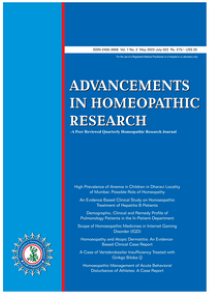Role of Homoeopathy in Hydrocele
Keywords:
Hydrocele, Testis, HomoeopathyAbstract
A hydrocele literally is an accumulation of serous fluid in a body cavity. A hydrocele of testis is the accumulation of fluids around a testicle. Hydrocele is collection of fluid along the path of testicular descent which usually presents as a painless, cystic scrotal mass leading to an increase in the volume of the scrotal contents. It is often caused by peritoneum wrapped around the testicle, called the tunica vaginalis. Primary hydroceles may develop in adulthood, particularly in the elderly and in hot countries, by slow accumulation of serous fluid. This is presumably caused by impaired reabsorption, which appears to be the explanation for most primary hydroceles, although the reason remains obscure. About 10% of newborn male infants have a hydrocele, which often clears up without any particular treatment within the first year of life. Hydroceles occur in only about 1% of adult men, and will often need treatment if it doesn’t disappear on its own. In this random clinical study, 55 patients of Hydrocele were considered for Homoeopathic treatment for a period of total two years, out of which 41 patients were recovered and the rest either dropped out or failed to recover. Out of these 55 patients who underwent treatment for hydrocele, 30 patients had right sided hydrocele, 23 patients had left sided hydrocele and 2 patients had bilateral hydrocele. The most common age group affected was the age group of 31-40 years which comprised of 20 patients, followed by age group between 21-30 years with 13 patients, 41-50 years with 11 patients and 51- 60 years with 08 patients, also 2 patients above 60 age and 2 patients below 20 age. The positive remedy response was mostly seen in Clematis Erecta and Rhododendron followed by Conium, Arnica, Berberis Vulgaris and Nux Vomica. This research paper will certainly help health professionals to overcome such problems of surgical cases and consider the benefits of the facts in role of Homoeopathy in hydroceles.




